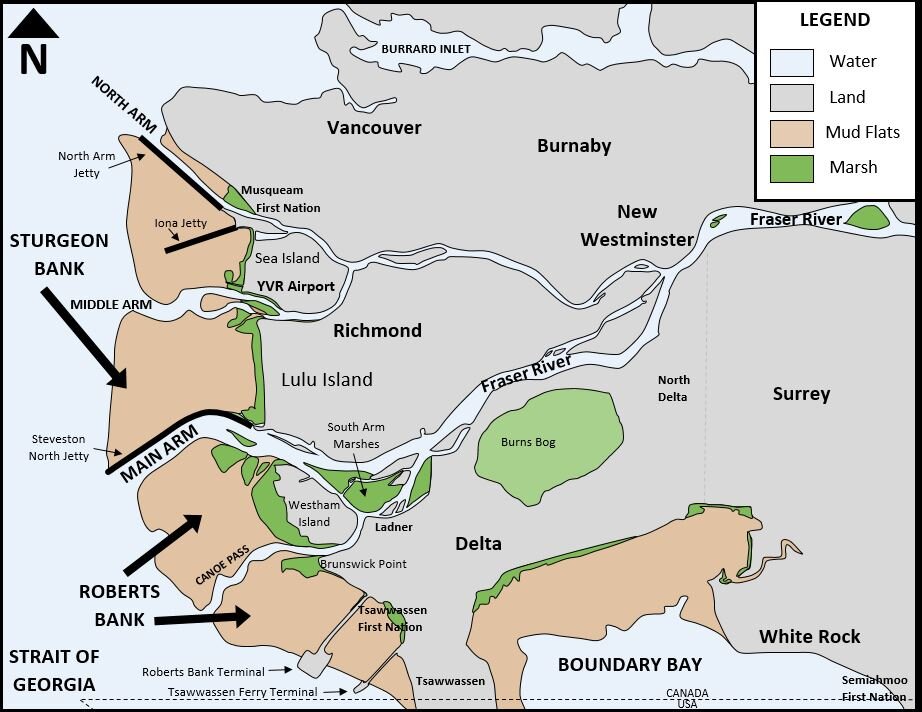
Delta is an uniquely important habitat for migratory and wintering birds, along with year round resident birds. Join us as we celebrate the success of the residents, community groups, and farmers — who together help these birds to survive.
Explore this website to learn about the ways you’re helping the Fraser River delta and estuary remain a world-class location for birds. And come back periodically for our changing, special profiles on the birds of Delta.

Birds love the Fraser River Delta’s farms, coastlines, forest and bogs.
You can see hundreds of different species of birds in the Fraser River delta. Songbirds like the Pacific Wren and the Varied Thrush shelter in forests. Birds of prey like the Northern Harrier and the Short-eared Owl soar above fields. Waterbirds, including the Pacific Loon and the Western Grebe, feed in the waters surrounding Delta. The mud flats of Roberts Bank, the shore between the South Arm of the Fraser River and Tsawwassen, is where 42-62 % of the global population of Western Sandpiper, a shorebird species, refuel and feed during migration (Drever et al. 2014).
In fact, many birders come from around the world just to glimpse Delta’s birds - watching Barn Owls glide over fields or Hermit Thrushes sing from a Douglas Fir’s highest branches.
View the Birds in Delta and Experience Birding in Delta guides for information on birds and bird watching locations within the City of Delta.
Coastlines
The Fraser River delta and estuary, Boundary Bay and its adjacent uplands represent the most significant migratory waterfowl and shorebird habitat on Canada's Pacific Coast. The bay stretches to Surrey, White Rock and down through the United States. It has a variety of habitats including mudflats, eel grass beds, salt marshes, sand dunes, grasslands and sandy shorelines. Mudflats along Roberts Bank can be many kilometers wide making excellent habitat for shorebirds. The mudflats support a number of invertebrates and microorganisms that are an important source of energy for migrating shorebirds.
Agricultural fields
Agriculture is important to Delta’s economic, environmental and social sustainability. Over 50 per cent of Delta’s land is agricultural based. Agricultural fields and their edges provide valuable habitat for local wildlife. Hedgerows provide habitat for song birds and overwintering waterfowl can be found digging for leftover root vegetables in local fields throughout Delta.
Overwintering waterfowl can damage farm fields and are costly to the landowner. Managing the needs of the waterfowl and working with the local farmers is key. You can support local agriculture by buying and eating local, or by growing your own food.
Old field habitat
Old field habitat is typically long-abandoned agricultural land where a range of grasses and shrub species have grown up. This habitat mimics the natural prairie, grassland and salt marsh habitats which used to exist here in Delta. Examples of old field habitat can be found in the North 40 dog park and Boundary Bay Regional Park. This environment provides habitat for a variety of birds & raptors (heron, owls, hawks, eagles, falcons), and small to medium mammals (voles, mice, rabbits, coyotes, deer).
Burns Bog
Burns Bog is a raised bog ecosystem covering approximately 3,000 hectares of the Fraser River delta between the south arm of the Fraser River and Boundary Bay. The largest undeveloped urban landmass in North America, Burns Bog is globally unique because of its chemistry, form, flora and large size. Burns Bog is an important contributor to the ecology of the region and supports rare species and plant communities. Burns Bog supports 175 birds species including Bald Eagles and Greater Sandhill Cranes. The high diversity of wildlife in Burns Bog is due to the wide variety of habitats that the bog provides, such as open water in ponds and ditches, Sphagnum fields, low and high shrub communities, and several different types of forest.
Fraser River delta & estuary map. Modified from Balke, E., 2017, Simon Fraser University.



